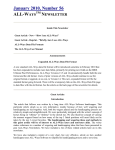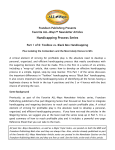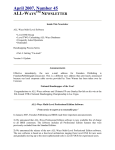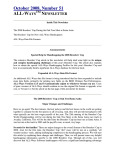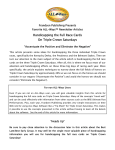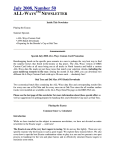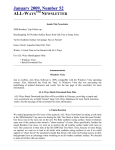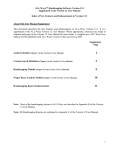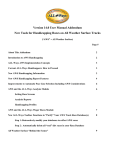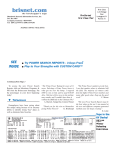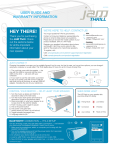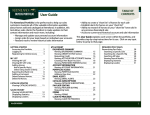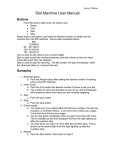Download Final Handicapping Process Series Part 2
Transcript
Frandsen Publishing Presents Favorite ALL-WaysTM Newsletter Articles Handicapping Process Series Part 2 of 6: “The Keystone” Plus Classifying the Favorite This six-part Handicapping Process Series covers, in a simple step-by-step manner, how to develop a personal, organized and efficient handicapping process that neatly coordinates with the wagering decisions that must be made. This Part 2 of the series expands on what we believe to be the Keystone of every successful handicapping process. More specifically, it covers how to isolate the 3 or 4 horses with the best chances of winning the race and it covers how to classify the crowd favorite as either “legitimate”, “vulnerable” or “false”. If we do a good job in the Keystone part of the handicapping process, all our other choices in the remainder of the process have a good chance of being effective. If you have not already done so, you will want to read Part 1 of this Handicapping Process Series. And, we suggest you also read at least the wrap up to our five-part Wagering Series, paying particular attention to the one page Summary Reference Sheet. These articles are posted in the Newsletter Section of the Frandsen Publishing Web site, more specifically in the Favorite Article Series section. All past ALL-Ways Newsletters, as well as a Major Topic Index, are posted on both the BRIS and Frandsen Publishing Web sites and they are always free. Also, articles already published as part of the Favorite ALL-Ways Newsletter Article series are posted in the Newsletter Section on the Frandsen Publishing Web site and they are free as well. See the links at the end of this article. Recap Part 1 of the series discussed the important differences between “Toolbox” handicapping versus “Black Box” handicapping. It also covered the important early handicapping tasks of identifying all the horses having a legitimate chance to finish in the top 4 positions and the 3 or 4 horses with the best chance of winning the race. Important Reminder Your primary handicapping job is to identify, in advance, the two out of three races that are not won by the crowd favorite and to identify the two non-favorite horses most likely to beat the favorite. Reminder: Here are the six sequential steps we believe should be part of an effective handicapping process: Step 1) From the full field of horses, isolate all horses having a legitimate chance to finish in the top four finish positions. (Must include the favorite) Step 2) Isolate the top 3 or 4 candidates to win the race. (Must include the favorite) Step 3) Classify the favorite as legitimate, vulnerable or false. Step 4) Identify the two non-favorite horses most likely to beat the favorite. Step 5) Identify a non-favorite Key Horse. Step 6) Make final handicapping decisions. For Non-ALL-Ways Users Even if you do not currently use ALL-Ways software, you will still gain helpful insights from this Handicapping Process Series. A number of ALL-Ways handicapping factors are used in this article to illustrate the handicapping process concepts that are discussed. These concepts “travel well” and can be used effectively with handicapping information from other sources, such as the BRIS Ultimate Past Performances. If you do want to try ALL-Ways software as you follow this Handicapping Process Series of articles, please see the box near the end of this article for how to do so. Part 2: The “Keystone” of the Process Part 1 of this series covered Steps 1 and 2 above. As promised, we are now going to cover Step 2 in more depth and we will present a simple way to classify the favorite as called for in Step 3. We consider Step 2 of the handicapping process in which we isolate the top 3 or 4 candidates to win the race, always including the favorite, to be the Keystone of the entire handicapping process. The reason for this is, when you have effectively completed Step 2, all the other steps in the entire six step process become relatively easy because they logically flow from what we learn in Step 2. When Step 1 is completed, we have all the horses identified that we believe are legitimate candidates to finish in the top four finish positions. They are all the horses designated by ALL-Ways software as Contenders plus any remaining Best Late horses plus any remaining BRIS Recent Top 10 Speed Performances horses plus any remaining horses designated by ALL-Ways software as Dangerous Non-Contenders. We consider Step 2 to be the Keystone because of the approach used, specifically to assign every horse from Step 1 to either Group 1 (win candidates including the favorite) or Group 2 (in-the-money candidates) or Group 3 (marginal players). If we do an effective job with this step, all our other decisions in the process have a good chance of being effective. The elements of Step 2 we presented in our last newsletter included assigning each horse to a group based on how it looks on the Top 10/Ranking Handicapping Report for the specific factors of BRIS Class, BRIS Speed 2/3, BRIS Combined 2/3, BRIS Prime Power and ALL-Ways Comprehensive. For turf races, you should also look at BRIS Turf Class and/or BRIS True Class. We suggested looking for “gaps” in each ranked list to help determine which Group to assign the horse. Then we suggested moving horses up or down between groups based on each horse’s suitability to the distance and surface, based on pace considerations and based on each horse’s current form. That is where we left off. Now we are going to explore Step 2 a bit more. Specifically, we will look at the concept of gap advantage/disadvantage, we have some additional comments on situational factors and we will present some ideas for using a couple of additional ALL-Ways software handicapping reports. Gap Advantage/Disadvantage First, what do we mean by “gap”? If a horse has a BRIS speed figure that is one point better than the next best speed figure horse, it has a slight gap advantage of one point. If a horse has a BRIS Speed figure that is five points better than the next best speed figure horse, is has a major five point gap advantage. In this case, the second best figure horse has a five point gap disadvantage. Let’s look at an example from a recent race at Keeneland. Our experience shows us that the gap advantages/disadvantages shown on the next page are significant. Gap Advantage/Disadvantage Example BRIS CLASS Significant Gap Advantages/Disadvantages BRIS Speed Ratings 2-4 points BRIS Class Ratings 1-2 points BRIS Combined Ratings 2-4 points BRIS Prime Power 3-4 points ALL-Ways Comprehensive 4-5 points BRIS SPEED 2/3 PG# Horse Name 3 2 5 7 1 6 4 8 WASTED TEARS FOREVER TOGETHER CARRIBEAN SUNSET *HOT CHA CHA *SALVE GERMAINIA QUIET HARBOR STARDOM BOUND TREAT GENTLY PAR 99 Rating 99 98 98 97 96 94 92 89 BRIS PRIME POWER PG# Horse Name 7 5 2 3 6 1 4 8 *HOT CHA CHA CARRIBEAN SUNSET FOREVER TOGETHER WASTED TEARS QUIET HARBOR *SALVE GERMAINIA STARDOM BOUND TREAT GENTLY BRIS COMBINED 2/3 PG# Horse Name 3 5 7 1 6 2 4 8 WASTED TEARS CARRIBEAN SUNSET *HOT CHA CHA *SALVE GERMAINIA QUIET HARBOR FOREVER TOGETHER STARDOM BOUND TREAT GENTLY PAR 120.4 Rating 120.7 120.1 119.9 119.7 119.6 119.5 118.7 118.0 PAR 195 Running Style Rating 196 194 192 190 187 186 180 168 E-8 P-4 S-2 S-0 S-1 S-0 S-0 P-5 ALL-Ways COMPREHENSIVE PG# Horse Name Rating PG# Horse Name 2 5 7 6 3 1 4 8 FOREVER TOGETHER CARRIBEAN SUNSET *HOT CHA CHA QUIET HARBOR WASTED TEARS *SALVE GERMAINIA STARDOM BOUND TREAT GENTLY 172.3 161.4 158.7 153.2 153.2 151.1 151.1 147.5 3 6 5 1 2 7 8 4 WASTED TEARS QUIET HARBOR CARRIBEAN SUNSET *SALVE GERMAINIA FOREVER TOGETHER *HOT CHA CHA TREAT GENTLY STARDOM BOUND Rating MORNING LINE 32 30 28 24 23 19 17 12 8-1 8-1 4-1 12-1 7-5 6-1 10-1 6-1 Notes: ∙ A horse’s name in bold print indicates an ALL-Ways designated Contender ∙ An asterisk (*) in front of a horse’s name indicates an ALL-Ways designated Dangerous Non-Contender ∙ The “2/3” notation means the figure is the average for the horse’s best 2 out of its last 3 races. ∙ The BRIS Combined Rating is the horse’s Early Pace Rating (2nd Call) plus Final Fraction Rating ∙ Running Style: The letter indicates “E” (Early), “P” (Presser) and “S” Sustainer. There are no “EP” (Early Presser) horses in the race. The number from 0 to 8 is the horse’s Quirin Speed Points, which measures a horse’s propensity to be on or near the lead at the 1st Call. An 8 rating indicates the horse wants/must have the lead. A 4 or 5 rating indicates the horse will likely be up close, but not on the lead. A 1 or 2 indicates no propensity to be on the lead or even up close at the 1st Call. The handicapping charts shown on the previous page are taken from the ALL-Ways Top 10/Ranking Handicapping Report. This report includes sixteen different ranked handicapping factor lists, five of which are shown, and three Top 10 Speed/Pace Performance lists, which are not shown above. Frequently, the gaps in these lists are very easy to spot. Indeed, this is the case with the BRIS Prime Power ranked list and, to some extent, with the ALL-Ways Comprehensive list as well. However, frequently some lists do not have glaring gaps between horses and it is important to know how to handle these situations. We explain how to do so below. Looking at BRIS Class: There is no significant gap between horses in this ranked list. Indeed there is only 1.2 points separating the top six horses. This indicates that class will not be a primary determining factor in this race. We do draw a line between #1 and #4 horses because there is at least a modest gap of .8 points. The #4 and #8 horses would more than likely have a difficult time overcoming their modest gap disadvantage when there are six horses in the higher ranked group. Looking at BRIS Speed 2/3: This is similar to the BRIS Class situation. We did draw a line between the #1 and #6 horses as it is the first full 2 point gap in the list. This gives us a fairly tight group of the top five horses in the list with only a 3 point spread between them, indicating that their speed ratings will not be a major determining factor between the top 5 BRIS Speed ranked horses. We also chose to draw a line between the #4 and #8 horses because of the 3 point gap. Looking at BRIS Combined 2/3: We chose to draw our first gap line between the #7 and #1 horses, The gap is only 2 points, but it gives us a group of three horses at the top within a 4 point range. We also draw a line between the #2 and #4 horses with a very large gap of 6 points. This gives us a second group of three horses within 5 points of each other. This BRIS Combined 2/3 ranked list clearly tells us to discount the #4 and #8 horses. Looking at BRIS Prime Power: The BRIS Prime Power Rating represents a comprehensive overall evaluation of each horse. There is a glaring 11.1 point gap between the #2 and #5 horses. There are also significant gaps between the #7 and #6 horses (5.5 points) and between the #4 and #8 horses (3.6 points). Looking at ALL-Ways Comprehensive: The ALL-Ways Comprehensive Rating is similar to the BRIS Prime Power Rating in that it is an overall evaluation of each horse. However, it uses a different approach than the BRIS rating and we have learned, over time, to always look at both of them. They are very powerful when used together (See ALL-Ways Newsletter #13). We draw our first gap lines between the #5 and #1 horses (4 points). This gives us a top group of three horses within a 4 point gap range. We also chose to draw a gap line between the # 7 and #8 horses even though the specific gap is only 2 points. What this does, however, is give us a second group of three horses all within 5 points of each other. Overall, we can quickly come to a few conclusions: First, class and speed ratings will not be the determining factors in this race, at least with respect to the primary contenders. Second, the BRIS Combined 2/3 Rating will be important in this race. Third, the BRIS Prime Power and ALL-Ways Comprehensive ratings evaluate the #2 and # 3 horses very differently. The Prime Power Rating favors the #2 horse, the 7 to 5 Morning Line Favorite and drops the #3 to about the middle. On the other hand, the Comprehensive Rating favors the #3 horse, 8 to 1 in the Morning Line, and relegates the #2 horse to the middle. In this case, these differences are most likely because the ALL-Ways Comprehensive Rating takes the pace of the race into consideration, including the BRIS Combined 2/3 Rating. After you have done this kind of analysis of all five factors (Class, Speed, Combined Pace, Prime Power and Comprehensive), you need to use your own logic to assign each horse to one of the following groups: Group 1 Group 2 Group 3 Candidates In-the-Money Candidates Marginal Horses Top 3 or 4 Win (Includes Favorite) In this example, #4 and #8 were already eliminated in Step 1 of our handicapping process. Looking at the gap analysis above certainly confirms this. Step 2 of our handicapping process tells us that, at this point, we need to include the crowd favorite in Group 1 as well as 2 or 3 additional possible winners. In an eight horse field, we prefer to limit Group 1 to just the favorite plus two additional horses. Clearly, the #3 horse must be included as it is ranked tops in BRIS Speed 2/3, BRIS Combined 2/3 and ALL-Ways Comprehensive. We narrowed down our third horse to go into Group 1 as either the #5 horse or the #7 horse. We chose the #5 because in every ranked list except BRIS Class, it was ranked slightly ahead of the #7. This means we put the #7 into Group 2 (In-the-Money Candidates) and we chose #6 for that group as well. Finally, we relegated the #1 horse to Group 3 (“Marginal” Horses). So, here is what our groupings look like at this point: Group 1 Group 2 (win) #2 FOREVER TOGETHER #3 WASTED TEARS #5 CARRIBEAN SUNSET Group 3 (in-the-money) 7-5 8-1 4-1 #6 QUIET HARBOR #7 *HOT CHA CHA 8-1 6-1 (marginal) #1 *SALVE GERMAINIA 12-1 Remember that horses we believe do not have a chance to finish in the top 4 finish positions are not in any of these groups. That is why the #4 and #8 horses are missing. Also, a horse can only be in one group at a time. Situational Considerations In our last newsletter, we discussed moving horses up and down between groups based on each horse’s suitability to the distance and surface, pace considerations and form considerations. We are adding to this effort the need to also evaluate the overall situation between the horse’s last 1 or 2 races and today’s race. You can easily accomplish this by asking and answering one of two questions: 1) If the horse ran well last race, is it reasonable to expect the horse to run well today or are there reasons why the horse may not do as well today? 2) If the horse did not run well in its last race, is it reasonable to expect the horse to run poorly today or are there reasons why the horse may do better? To answer these questions, we consider today’s surface, distance, class level, pace match-up and track compared to the horse’s last one or two races. Now, there is a very big special consideration in this sample race and it has to do with the pace scenario. The ALL-Ways Race Pace Shape of this race is “E-P”, meaning it is a “Lone Early” race. The #3 horse is an “E” horse and all other horses are “P” or “S” horses, all late runners. The #3 horse had the highest BRIS Early Pace Rating (not shown), which is measured from the gate to the 2nd Call. Furthermore, the #3 horse has the highest possible Quirin Speed Point Rating of 8, meaning it absolutely wants/needs the lead at the 1st Call. Without doubt, the #3 horse will get a big uncontested lead on this otherwise very slow paced field. The #2 horse, the Morning Line favorite, is a late running “S” horse and indeed had the highest BRIS Final Fraction Pace Rating. This is a classic “best early vs. best late” scenario. So you can envision the #3 horse trying to hold onto the lead down the stretch run and the #2 horse trying to run the #3 down. Given the very big 10 point BRIS Combined 2/3 Rating gap advantage the #3 has over the #2, we believe the #2 will have a hard time catching and passing the #3. We will look at this again further down when we get to Step 3, “Evaluating the Favorite”. Handicapping Reports The Top 10/Ranking Report is very helpful for doing the kind of analysis we need for Step 2 of our handicapping process. The report has another nice feature in that, if you run the report again after the races are completed and the results entered automatically by ALL-Ways software, the top four finishers will be identified in each handicapping factor list on the report. This is a great way to help you continuously improve your handicapping process. The Pace Line Report is also a good report to use in addition to the Top 10/Ranking Report because it shows all the horses in post position order. It is a good place to make your notes about each horse. Finally, if you are interested in a single report that has just about every handicapping consideration on one page, you may want to try the Spot Play/Final Process Report. This report is particularly good to use with a yellow marker denoting “good” and an orange marker for “bad”. The Pace Line and Spot Play reports also identify the top four finishers after the results are entered. Note: Appendix C of the User Manual explains each ALL-Ways Software handicapping report. Step 3 Classifying the Favorite When you reach this point in the process, you are well prepared to complete Step 3 of classifying the favorite. Here is a very easy and fast way to do this. It really explains why we consider Step 2 to be the Keystone of our handicapping process. At this point, the favorite plus 2 or 3 other horses must be in Group 1, the horses with a good chance to win the race. Here is the trick. Even though the favorite must be in Group 1 at this point in the process, in Step 2 you still want to evaluate the favorite along with all the other horses in the same way. If your evaluation would have put the favorite in Group 1 anyway, the favorite is “Legitimate”. If you would have assigned the favorite to Group 2, the favorite is “Vulnerable”. If you would have assigned the favorite to Group 3, the favorite is “False”. In our example, as explained above, we certainly believe the #2 is vulnerable because it will be at a big pace disadvantage against the #3 horse that will have a big, uncontested lead on the field. The 10 point BRIS Combined 2/3 gap advantage of the #3 horse over the #2 horse is very strong. The #2 horse, while at a pace disadvantage, is still a good horse with a chance to win the race and certainly with a good chance of coming in 2nd, so we would not consider it as “false”. But, it is vulnerable in terms of winning the race. Note: For more information on evaluating favorites, we refer you to the Favorite ALL-Ways Article Series article titled “The Curse of the Legitimate Favorite”. Summary: At this point we have completed the first 3 steps of our handicapping process. More specifically, we have: 1) Isolated all horses having a legitimate chance to finish in the top four finish positions; 2) Isolated the top 3 or 4 candidates to win the race; 3) Classified the favorite as legitimate, vulnerable or false. Here are the actual race results: Wasted Tears (#3) went off at 5 to 1 and did hold on for the win against the expected challenge of Forever Together (#2) that went off as the 2 to 1 favorite. Hot Cha Cha (#7) took the show position at 7 to 1 and Carribean Sunset (#5) took 4th at 7 to 2. The $2 Exacta paid $41.40 and the $2 Trifecta paid $229.40. ALL-Ways Software Gap Analyses ALL-Ways Software includes a Gap Advantage Analysis of each key handicapping factor that shows how horses perform in terms of win and in-the-money percentages and flat bet win wager profitability based on the size of their Gap Advantage. It also includes a Gap Disadvantage Analysis that shows how this performance declines as the Gap Disadvantage increases. What’s Next? Handicapping Process Series Part 3 of 6: “Key Decisions”: Part 3 of the series covers how to go about making the key handicapping decisions that are so critical for our success as we move from handicapping to wagering. This includes identifying the two non-favorite horses with the best chance to beat the favorite and identifying a good Key Horse to use in our wagers. For Non-ALL-Ways Users If you ever thought of giving ALL-Ways software a try, now is a great time to do it. This will let you follow this Handicapping Process Series to gradually ease into the use of ALL-Ways software while, at the same time, developing a personal, profitable, handicapping and wagering process. We suggest new ALL-Ways software users visit the “What’s New Page” on the Frandsen Publishing Web site and click the link to “Getting Started With ALL-Ways”. When you are there, we suggest you print and read the short paper on “How ALL-Ways Works” and also note the options presented for a “Fast Track” approach, an “Accelerated Track” approach and an “As You Go approach”. Note that you can download ALL-Ways Software for free from the Free Software Page on the BRIS Web site. When you install the software, it automatically includes a sample race card data file that you can use to explore the concepts presented in the Handicapping Process Series. ALL-Ways™ Newsletter Handicapping Process Series Reference Sheet Supporting Full Field of Horses “Favorite Articles” Isolate All Contenders for the Top 4 Finish Positions ● Wagering Series Part 1 “Realistic Expectations” Part 2 “3 Critical Skills” Part 3 “How Are You Really Doing?” Part 4 “Where to Go from Here” Part 5 “Wrapping It Up” The Keystone Steps ● Initial Assignments ● Assign to a Group based on speed, class, compound pace and comprehensive ratings using the concept of Gap Advantage. Exclude horses no longer under consideration. Group 1 Group 2 Group 3 Top 3 or 4 Win Candidates In-the-Money Candidates Marginal Horses ● Handicapping Process Series Part 1 “Isolating Contenders” Part 2 “ Keystone of the Process” Part 3 “Key Decisions” Part 4 “Getting Unstuck” Part 5 “Feedback” Part 6 “Wrapping It Up” ● “Fourth … place … itis” How to Avoid It ● Race Pace Shapes Include Favorite ● Final Assignments ● Move horses between groups based on suitability to surface/distance, the pace scenario, form factors and situational changes from past performance races to today’s race Group 1 Group 2 Top 3 or 4 Win Candidates In-the-Money Candidates Group 3 Marginal Horses Evaluate the Favorite Decide which group you would now assign the favorite If Group 1: Legitimate If Group 2: Vulnerable If Group 3: False Key Decisions Decide: Pass or Play the Race. Remember “The Curse of the Legitimate Favorite Group 1 Select 2 Non-Favorite Win Candidates Select a Key Horse and/or a Show Partial Parlay Horse ● The Curse of the Legitimate Favorite ● To Pass or to Play? That Should Be the Question ● How I Use ALL-Ways A compilation of articles submitted by ALL-Ways handicappers The Foundation Wagers ● The 2-Horse Win Wager ● The Win-Insurance Wager ● Show Partial Parlay Wager - Part 1 “Getting Started” - Part 2 “Becoming an Expert” ALL-Ways Newsletters and articles making up the Favorite Article Series are posted in the Newsletter Section of the Frandsen Publishing Web site at www.frandsen.com. They are free. © Copyright 2010 Frandsen Publishing Corporation © Copyright 2010 Frandsen Publishing Corporation All Rights Reserved Email: [email protected] Web Site: www.frandsen.com Phone: 952.937.9180 Frandsen Publishing Corporation is the publisher of the quarterly ALL-Ways Newsletters, which are widely considered to be one of the best sources of handicapping and wagering insights available in the industry. And, ALL-Ways Newsletters are FREE! These newsletters are posted on both the BRIS and Frandsen Publishing Web sites. All articles that are part of the Favorite ALL-Ways Newsletter Article series are available on the Frandsen Publishing Web site. All Newsletters and Major Topic Index Frandsen Publishing is also the developer of ALL-Ways Handicapping Software. ALL-Ways is serious software for professional and serious horseplayers. Phillips Racing Newsletter calls ALL-Ways Software “absolutely the best free handicapping tool on the market” and gives ALLWays a 9 ½ rating … the highest ever awarded. And, ALL-Ways Software is FREE! More about ALL-Ways Software Bloodstock Research Information Services and Frandsen Publishing Corporation are pleased to provide ALL-Ways Software, ALL-Ways Newsletters and the “Favorite ALL-Ways Newsletter Articles” series, all for FREE. .












